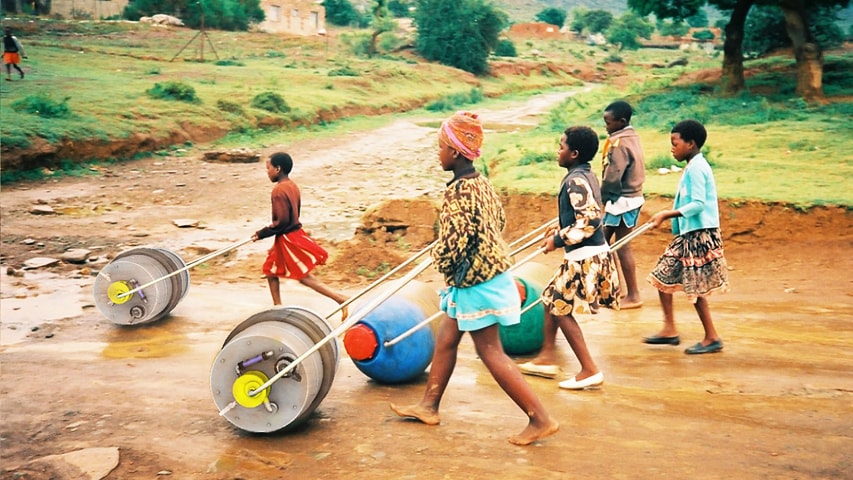Students Design Water Barrel That Filters as it Rolls

A photo illustration depicts a water transportation and purification system concept (front), which uses a double-barrel design to pump water through a filter using the mechanical energy generated by the rolling motion, alongside existing water transportation system Hippo Roller (original image from hipporoller.org).
For those who live in regions where water pours from tubes in their homes, it might be difficult to imagine that there are still people on Earth without access to clean water.
But what about a single device that could do both?
"We had already seen some ideas out there that filtered water, and others that rolled the water using barrels, but we wanted to create something that filtered while you rolled," said Mechanical Engineering (MechE) senior Deepak Ravi. "Something better than doing the two of them separately."
Ravi and fellow MechE seniors Anna Mirabella, Jack Kaplan, Veronica Jaime-Lara, and Alex Baker put their heads together and designed the Water Transportation and Purification System.
"The design is basically a big barrel with a smaller barrel inside of it, attached to a handle," Mirabella said. "As you roll the barrel along, the relative motion between the handle and the spinning barrel pulls dirty water from the outer barrel through a filter and into the inner barrel where it stores the newly cleaned water."
The design uses only a few simple parts and requires no power, only mechanical energy provided by the rolling of the barrel. It uses a Sawyer water filter, which never needs to be replaced, and recycled industrial barrels — food-grade plastic barrels that are normally thrown away. With PVC pipe for the handle, the whole prototype cost only about $200. When mass-produced, the team estimates the total cost at only $40 per unit.
"We've decided to make this design open source," Mirabella said. "If someone wants to manufacture our system and get it down to that $40, none of us would be upset. It would be awesome to have had a small part of something big."
Another way this product will keep costs down for the user is its instantaneous filter. Since the water is already purified en route home, users can empty the clean water into a container, then hand the device off to their neighbor. That way, a single device can be shared among an entire community.
The team developed the idea as the final project for their Mechanical Engineering Senior Design course, taught by Associate Teaching Professor Noé Vargas Hernández. The class is required of all MechE majors for graduation and emphasizes the ability to take a project from conception to prototype over the course of a semester.
"This wasn't just a mechanical engineering project for us," Ravi said. "Some of us are also design minors, so we thought about how it would be filled, and how it would be made. We thought about the user. That’s why we went with a 15-gallon tank; 15 gallons is about a weekly supply of water for a family in the developing world."
"I think that’s one of the best things about being able to work here at Carnegie Mellon," he said. "All of our different disciplines combine to make the best outcome."
Related: